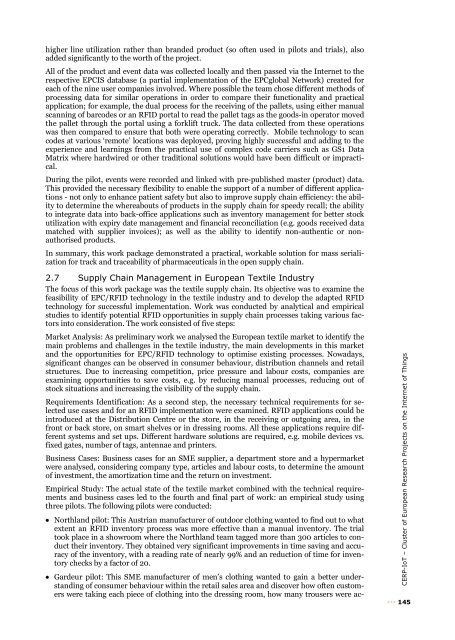Vision and Challenges for Realising the Internet of Things
Vision and Challenges for Realising the Internet of Things
Vision and Challenges for Realising the Internet of Things
You also want an ePaper? Increase the reach of your titles
YUMPU automatically turns print PDFs into web optimized ePapers that Google loves.
higher line utilization ra<strong>the</strong>r than br<strong>and</strong>ed product (so <strong>of</strong>ten used in pilots <strong>and</strong> trials), also<br />
added significantly to <strong>the</strong> worth <strong>of</strong> <strong>the</strong> project.<br />
All <strong>of</strong> <strong>the</strong> product <strong>and</strong> event data was collected locally <strong>and</strong> <strong>the</strong>n passed via <strong>the</strong> <strong>Internet</strong> to <strong>the</strong><br />
respective EPCIS database (a partial implementation <strong>of</strong> <strong>the</strong> EPCglobal Network) created <strong>for</strong><br />
each <strong>of</strong> <strong>the</strong> nine user companies involved. Where possible <strong>the</strong> team chose different methods <strong>of</strong><br />
processing data <strong>for</strong> similar operations in order to compare <strong>the</strong>ir functionality <strong>and</strong> practical<br />
application; <strong>for</strong> example, <strong>the</strong> dual process <strong>for</strong> <strong>the</strong> receiving <strong>of</strong> <strong>the</strong> pallets, using ei<strong>the</strong>r manual<br />
scanning <strong>of</strong> barcodes or an RFID portal to read <strong>the</strong> pallet tags as <strong>the</strong> goods-in operator moved<br />
<strong>the</strong> pallet through <strong>the</strong> portal using a <strong>for</strong>klift truck. The data collected from <strong>the</strong>se operations<br />
was <strong>the</strong>n compared to ensure that both were operating correctly. Mobile technology to scan<br />
codes at various ‘remote’ locations was deployed, proving highly successful <strong>and</strong> adding to <strong>the</strong><br />
experience <strong>and</strong> learnings from <strong>the</strong> practical use <strong>of</strong> complex code carriers such as GS1 Data<br />
Matrix where hardwired or o<strong>the</strong>r traditional solutions would have been difficult or impractical.<br />
During <strong>the</strong> pilot, events were recorded <strong>and</strong> linked with pre-published master (product) data.<br />
This provided <strong>the</strong> necessary flexibility to enable <strong>the</strong> support <strong>of</strong> a number <strong>of</strong> different applications<br />
- not only to enhance patient safety but also to improve supply chain efficiency: <strong>the</strong> ability<br />
to determine <strong>the</strong> whereabouts <strong>of</strong> products in <strong>the</strong> supply chain <strong>for</strong> speedy recall; <strong>the</strong> ability<br />
to integrate data into back-<strong>of</strong>fice applications such as inventory management <strong>for</strong> better stock<br />
utilization with expiry date management <strong>and</strong> financial reconciliation (e.g. goods received data<br />
matched with supplier invoices); as well as <strong>the</strong> ability to identify non-au<strong>the</strong>ntic or nonauthorised<br />
products.<br />
In summary, this work package demonstrated a practical, workable solution <strong>for</strong> mass serialization<br />
<strong>for</strong> track <strong>and</strong> traceability <strong>of</strong> pharmaceuticals in <strong>the</strong> open supply chain.<br />
2.7 Supply Chain Management in European Textile Industry<br />
The focus <strong>of</strong> this work package was <strong>the</strong> textile supply chain. Its objective was to examine <strong>the</strong><br />
feasibility <strong>of</strong> EPC/RFID technology in <strong>the</strong> textile industry <strong>and</strong> to develop <strong>the</strong> adapted RFID<br />
technology <strong>for</strong> successful implementation. Work was conducted by analytical <strong>and</strong> empirical<br />
studies to identify potential RFID opportunities in supply chain processes taking various factors<br />
into consideration. The work consisted <strong>of</strong> five steps:<br />
Market Analysis: As preliminary work we analysed <strong>the</strong> European textile market to identify <strong>the</strong><br />
main problems <strong>and</strong> challenges in <strong>the</strong> textile industry, <strong>the</strong> main developments in this market<br />
<strong>and</strong> <strong>the</strong> opportunities <strong>for</strong> EPC/RFID technology to optimise existing processes. Nowadays,<br />
significant changes can be observed in consumer behaviour, distribution channels <strong>and</strong> retail<br />
structures. Due to increasing competition, price pressure <strong>and</strong> labour costs, companies are<br />
examining opportunities to save costs, e.g. by reducing manual processes, reducing out <strong>of</strong><br />
stock situations <strong>and</strong> increasing <strong>the</strong> visibility <strong>of</strong> <strong>the</strong> supply chain.<br />
Requirements Identification: As a second step, <strong>the</strong> necessary technical requirements <strong>for</strong> selected<br />
use cases <strong>and</strong> <strong>for</strong> an RFID implementation were examined. RFID applications could be<br />
introduced at <strong>the</strong> Distribution Centre or <strong>the</strong> store, in <strong>the</strong> receiving or outgoing area, in <strong>the</strong><br />
front or back store, on smart shelves or in dressing rooms. All <strong>the</strong>se applications require different<br />
systems <strong>and</strong> set ups. Different hardware solutions are required, e.g. mobile devices vs.<br />
fixed gates, number <strong>of</strong> tags, antennae <strong>and</strong> printers.<br />
Business Cases: Business cases <strong>for</strong> an SME supplier, a department store <strong>and</strong> a hypermarket<br />
were analysed, considering company type, articles <strong>and</strong> labour costs, to determine <strong>the</strong> amount<br />
<strong>of</strong> investment, <strong>the</strong> amortization time <strong>and</strong> <strong>the</strong> return on investment.<br />
Empirical Study: The actual state <strong>of</strong> <strong>the</strong> textile market combined with <strong>the</strong> technical requirements<br />
<strong>and</strong> business cases led to <strong>the</strong> fourth <strong>and</strong> final part <strong>of</strong> work: an empirical study using<br />
three pilots. The following pilots were conducted:<br />
Northl<strong>and</strong> pilot: This Austrian manufacturer <strong>of</strong> outdoor clothing wanted to find out to what<br />
extent an RFID inventory process was more effective than a manual inventory. The trial<br />
took place in a showroom where <strong>the</strong> Northl<strong>and</strong> team tagged more than 300 articles to conduct<br />
<strong>the</strong>ir inventory. They obtained very significant improvements in time saving <strong>and</strong> accuracy<br />
<strong>of</strong> <strong>the</strong> inventory, with a reading rate <strong>of</strong> nearly 99% <strong>and</strong> an reduction <strong>of</strong> time <strong>for</strong> inventory<br />
checks by a factor <strong>of</strong> 20.<br />
Gardeur pilot: This SME manufacturer <strong>of</strong> men’s clothing wanted to gain a better underst<strong>and</strong>ing<br />
<strong>of</strong> consumer behaviour within <strong>the</strong> retail sales area <strong>and</strong> discover how <strong>of</strong>ten customers<br />
were taking each piece <strong>of</strong> clothing into <strong>the</strong> dressing room, how many trousers were ac-<br />
CERP-IoT – Cluster <strong>of</strong> European Research Projects on <strong>the</strong> <strong>Internet</strong> <strong>of</strong> <strong>Things</strong><br />
145
















